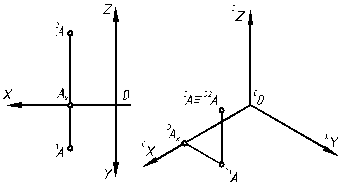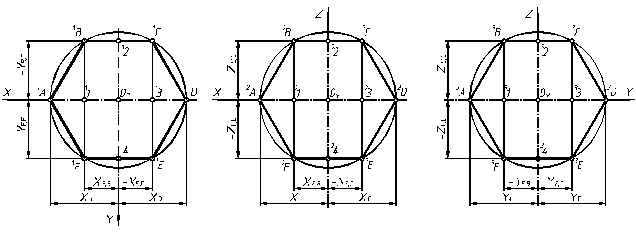Let’s consider modeling of an axonometry of point, line and plane figure in rectangular izometry.
In izometry coefficients of distortion on the axes of х, y, and z are equal and equal 1.

a) b)
Figure 3.8 – Modeling of a point in axonometry
The segment ОАх (figure 3.8, a) put from a point 00 for the axes 0х of the axonometrical system of coordinates (figure 3.8, b). Through the obtained point 0Ах draw a straight line, parallel to 0у, on which a segment is drown, equal a segment Ах 1А. . Point 01А is obtained from which draw a straight line, parallel 0z . On this line draw the segment 01А02А, equal the segment of Ах2А. The obtained point 0А is the isometric projection of point A. The axonometrical segments make an axonometrical coordinate plane.
Making the considered model for every point of axonometrical figure, we can draw the model of this figure in axonometrical projections. Figure 3.9 b shows the construction of rectangular izometry for the segment AB, and figure 3.10 b shows a construction of rectangular izometry of a plane figure ABC.

а) b) а) b)
Figure 3.9 – Figure 3.10 –
Construction of rectangular izometry onstruction of rectangular izometry for the segment AB of a plane figure ABC
Let’s consider the modeling of rectangular izometry of a plane figurewhich is in a plane of projections (or in a level plane). As flat figures have two measurings that is why for their modeling in axonometry two axes are used, which are chosen depending on to which of the planes of projections the figure is parallel.

А) b) c)
Дата добавления: 2016-07-18; просмотров: 1581;











